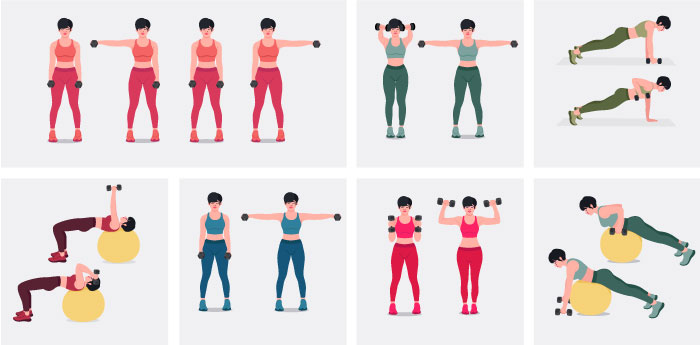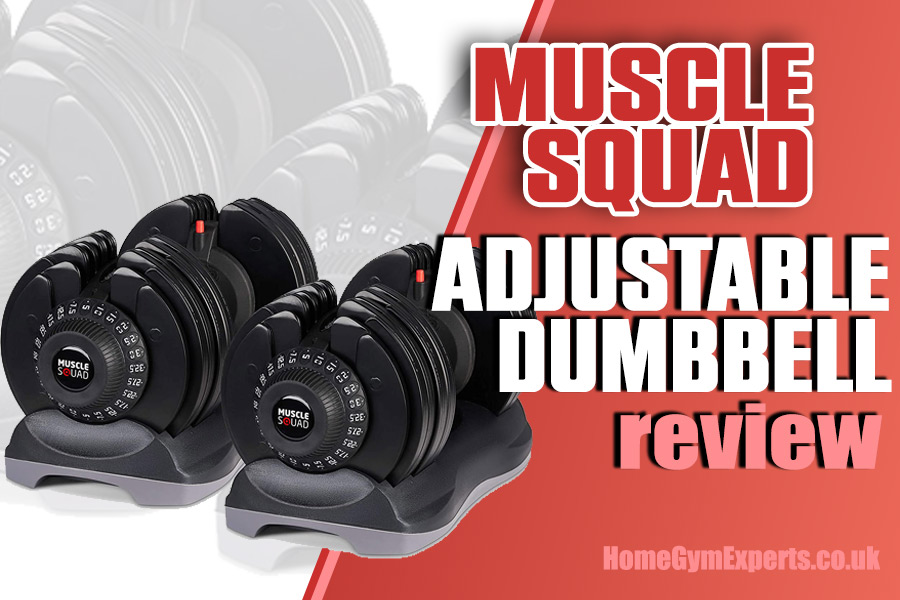
Dumbbells are a core piece of fitness equipment that will be found in any good gym. They typically range from 0.5kg right up to 50kg and can be used to perform a variety of moves. In this post, we are going to layout 9 huge dumbbell benefits.
We recommend reading on even if you already use dumbbells, as you might discover new ways to get more out of your weights.
1) You can train every body part… with a bit of practice
When most people think about dumbbells they might mainly think about them in terms of a few exercises, like the classic dumbbell curls. But that’s just the beginning of what you can train and workout with these fantastic, simple hand weights.
Think of a muscle and there will be an almost limitless number of ways you can target it with a dumbbell. Popular exercises are:
- Goblet squats – for thighs, backs of your legs and hips
- Bent over rows – (ouch) these hit your back, arms and shoulders at once
- Dumbbell clean and press – an insanely good exercise that works pretty much every part of your body at once.
- Dumbbell front raises – For Arms, shoulders, back and core muscles
2) Asymmetric training is a massive benefit to dumbbells
Shoulder presses target the muscles in the shoulders and can be a satisfying part of the body to work on because the results will add width and bulk to your frame. Moreover, they are super simple and eradicate the risk of asymmetric training (i.e. your stronger side taking over).
Stand, sit or squat (beginners might want to stand) while holding a dumbbell in each hand in an overhand grip. Drive the weights upwards until they are above your head and your arms are fully extended, then bring them back down to your shoulders and repeat.
3) They allow for some unique leg exercises
Things get more interesting when you start to combine dumbbells with lower-body moves. The lower body is where the largest and strongest muscles are located, so when you are training this area with dumbbells you get to pick weights from the heavier end of the rack. There is no better feeling than picking up a big weight and performing a perfect set!
Doing the perfect dumbbell squat at home
You can add dumbbells to squats by holding a single weight or by holding a lighter weight in each hand (the sum of which will equal your total added weight) in one of the following positions:
- Down by your side
- To your centre
- Sitting the weights on your shoulders. If you opt for your shoulders, use double weights to ensure even dispersion. The same can be applied to other lower-body moves, such as lunges.
Related Hand Weight Guides
- Dumbbell Buying Guide – The Ultimate Beginner’s Guide To Hand Held Weights
- Water Filled Dumbbells Review – A Good Portable Free Weight Solution?
- Are Dumbbells Safer Than Barbells?
- Are Adjustable Dumbbells Worth It [ The Verdict ]
- Rubber Hex Dumbbells – Complete Guide
4) Unilateral training – training one side at a time
Some people say that they have one side weaker than the other, we prefer to say that we have one side stronger than the other! It is natural for your dominant side to be more developed because it gets the most use. Dumbbells, because of their design, can be used to unilaterally train each side, thus evening out any imbalance.
Another benefit of unilateral training, when you train one side at a time, is that it disrupts the usual balance and forces your body to readjust to an uneven dispersion of weight, which strengthens the core stabilizer muscles.

5) You’ll get a full-extension
As compared to barbells and machines, dumbbells allow you to move freely and perform each rep with full muscle extension, thus allowing you to get more from your workout. With this, however, comes the risk of overextension, so it is vital to exercise with good form to avoid injury.
6) Dumbbells are ideal for building build endurance muscle with HIIT
Dumbbells, particularly the ones below your maximum weight point, are great for HIIT. This involves 3–5-minute intervals of reps performed at a decent speed. The challenge lies not so much in the weight of the dumbbell, but in sustaining the pace for the duration of the interval.
This form of training helps to build endurance muscle, which is less bulky than the muscle you would gain from training in the way laid out in points 1-3. Endurance muscle supports overall muscle wellbeing and fluid motion.
7) It’s easy to vary timing when training with dumbbells
Another way to train with dumbbells is to concentrate on the timing of each rep. This keeps the muscle under constant resistance and can help you to get more out of a set of weights without having to size up. To give this a go, allow for 3 seconds on the way down, 1-second hold and 1 second sharp up.
8) You can use them for cardio!
Have you ever seen a 0.5kg weight and wondered, what’s the point? Cardio! Holding light weights while performing cardio exercises adds a layer of resistance that intensifies the exercise.
Obviously, this is only suitable for some types of cardio…you will not get much benefit from holding weights while sat on a spin bike! But jogging, aerobics and dance can all be zhuzh up with the addition of lightweights.

9) They’re cheap, easy to find and practical
Dumbbells are accessible and practical pieces of fitness equipment. Lighter weights are easy to find at good prices, even large supermarkets have been known to stock them. There is no need to buy a full weight rack either, you can simply buy the weights you need and add them to your collection as you progress. And they can be stored in a cupboard or under the bed.
If you have never used dumbbells before, begin with a light pair and perform each rep slowly and carefully. You can always move up a weight if you find this to be too easy, but you will feel it the next day if the weight is too heavy!
Reference and Further Reading
- Medical News Today – Health benefits of dumbbells
- Healthline – What Is Muscular Strength and What Are Some Exercises You Can Do?
- WebMD – What to Know About Dumbbells
- Live Healthy Chron – What Muscles Benefit From Dumbbell Deadlifts?






![Are Adjustable Dumbbells Worth It? [ The Verdict ] Are Adjustable Dumbbells Worth It](https://www.homegymexperts.co.uk/wp-content/uploads/2021/07/Are-Adjustable-Dumbbells-Worth-It-1-900x600.jpg)


